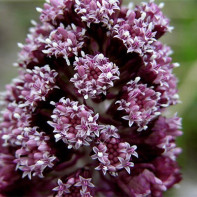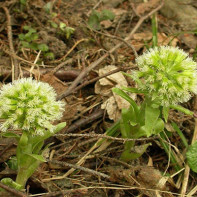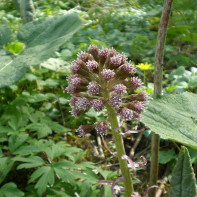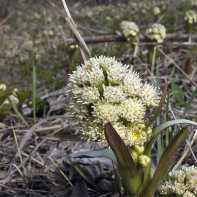White knotweed: medicinal properties and contraindications
Sagebrush is a popular medicinal plant that can be found on almost every shore of a body of water located in the Northern Hemisphere. This genus is most common in the Mediterranean countries, the European part of Russia, the Far East, Siberia and North America. White knotweed has medicinal properties and can be used as part of the complex treatment of diseases of the digestive system, respiratory organs, skin and reproductive sphere. To start using this plant, you need to know - how and in what diagnoses it can be useful, how to properly prepare remedies, dosage and take them.
- Chemical composition
- How it looks and where it grows
- Types
- Collection and storage
- Therapeutic properties of butterbur
- Butterbur in traditional medicine
- For coughs
- For headache and migraine
- From worms
- Epilepsy
- Insomnia
- From rheumatism
- For gout
- From pancreatitis
- In chronic fatigue
- Kinds of medicinal compositions
- Infusion
- Infusion
- Decoction
- Cosmetic application
- Face massage
- Balm for hair
- Therapeutic lotion for face
- Contraindications to use
Chemical Composition
The composition of butterbur has not been fully studied. But to date, scientists have already been able to conclude that this plant has therapeutic efficacy.
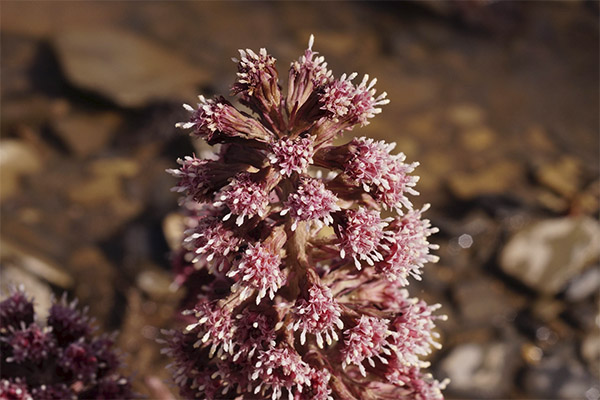
Through chemical analysis, scientists have been able to determine that the plant contains the following groups of active substances:
- tetracyclic and pentacyclic saponins;
- flavonoids (isoquercitin, astralgin and quercetin);
- tannins of various types;
- esters and essential oils;
- 12 types of organic acids;
- B vitamins (except B1 and B12);
- Isopetasin and neopetasin;
- cholines;
- petazole;
- carotenoids;
- mineral compounds;
- manganese in record concentrations.
The only obstacle to the mass use of butterbur in the pharmaceutical industry is the presence of toxic substances, which are present in high concentrations in the leaves of the plant. They negatively affect the nervous system, overload the liver and kidneys.
A Swiss pharmaceutical company was able to find a way to effectively purify the obtained extracts from toxic alkaloids. After this discovery, the herb began to be massively used as one of the components of herbal preparations for the treatment of laryngitis, bronchial asthma, hypertension, acute respiratory infections, migraine and many infectious diseases. But the presence of useful substances is not canceled by the presence of toxic alkaloids. The plant is recognized in the territory of the Russian Federation and is included in the register of medicines.
How it looks and where it grows
White knotweed is a genus of herbaceous plants with an annual or perennial cycle of development. It belongs to the family Asteraceae. The range of this herb is Europe, Asia, and parts of North America and Africa. The most common species used for medicinal purposes is medicinal white knotweed, or hybrid. It has these botanical characteristics:
- The maximum height of the plant is 50-70 cm.
- The rhizome is fleshy, with scales and multiple cord-like outgrowths.
- Large rounded or heart-shaped leaves with thick veins, forming a root rosette.
- Narrow and long sessile maroon leaves, completely covering the stems.
- Spiky or paniculate inflorescences consisting of numerous purple or red flowers.
- Fruits are small, cylindrical shaped achenes, capsules.
Depending on the growing conditions, medicinal white knotweed, or hybrid, may have slightly different botanical characteristics.
Species
The botanical characteristics of each variety differ sometimes dramatically. Like all representatives of the Aster family, whitetail has typical features that give away its belonging to this group of plants. In the Russian Federation, the most common species of butterbur are:
- glacial;
- rock butterbur;
- fragrant;
- hybrid;
- smooth.
In some historical documents, there is information that many centuries ago the peoples of the Arctic and Siberia used the plant for culinary purposes. In Japan and China, the hairy white knotweed is very common, and there it serves as an ingredient in many traditional dishes.
Harvesting and storage
The raw material should be harvested in an environmentally clean area, where there are no roads, cattle dumps, burial of toxic waste, economic activities and industrial plants. Here are the main rules of collection:
- leaves cut from the beginning of July to the end of August, dry in the shade;
- rhizomes are to be dug out at the end of September;
- inflorescences are harvested rarely, cut them during flowering.
Roots are advised to dry in an oven, at 50 degrees for 4-6 hours. Inflorescences and leaves are better dried in the open air, spread on paper or on oilcloth. And when the raw material is ready for storage, you can wrap it in jars or boxes and store in a room with low humidity, away from the sources of extraneous odors.
Therapeutic properties of butterbur
Butterbur contains more than 30 active ingredients that influence different areas of human health. Due to the presence of these components, the plant has pronounced medicinal effects:
- Butterbur is used as a powerful natural pain reliever for headaches, migraines.
- Substances that activate tissue regeneration and have a disinfectant effect is used in the treatment of skin diseases.
- The entire above-ground part of the plant contains active ingredients that are effective in the treatment of coughs. They dilute sputum, accelerate its elimination from the body, ease breathing and eliminate bronchospasm.
- White knotweed has a mild sedative and calming effect, so it is used for neuroses, to improve stress resistance and to combat insomnia.
- It is a powerful natural anticoagulant. The plant thins the blood, prevents the formation of blood clots, and cleanses the blood vessels.
- The herb has antipyretic properties, lowers body temperature, makes the sweat glands work actively, due to which the mechanisms of thermoregulation are activated.
- The plant is also known for its antispasmodic action, is used for abdominal pain of various etiologies.
Butterbur beneficial effects on the digestive system, regulates the production of enzymes, normalizes metabolism and promotes the breakdown of fats in the body. Due to this, the functioning of the liver is maintained, cholesterol is eliminated, and the risk of heart attack and stroke is reduced.
Nettle cinquefoil in traditional medicine
It is desirable to carry out the treatment of butterbur under the supervision of a doctor. At a minimum, it is necessary to consult with a specialist beforehand, so as not to harm the body. This plant can be used for a variety of diseases and conditions, but you need to know how to properly prepare remedies from it, how to dose them.
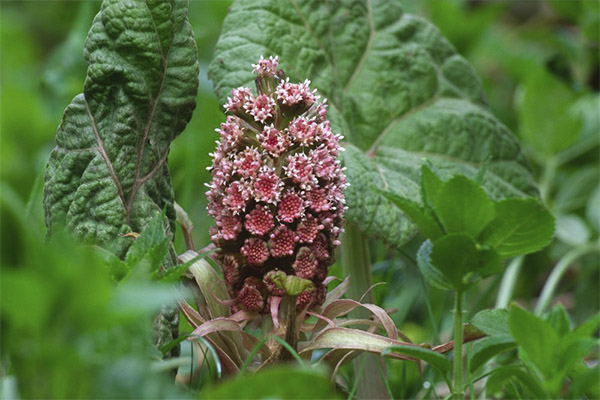
From coughs
The advantage of whitebriar is that it is versatile. This plant copes equally well with both dry and productive coughs. In addition to its anti-cough effect, it also helps expel phlegm faster, boosts the immune system to fight infection and makes breathing easier by relieving cramps.
To cope with a cough, you need to prepare an aqueous decoction from the leaves of the plant according to the following recipe:
- Take 2 tablespoons of dry collection;
- Pour 250 ml of boiling water;
- Boil for 15 minutes on a steam bath;
- Strain when cooled.
Take the resulting liquid three times a day, 1 tablespoon with water. The maximum duration of treatment with butterbur is 2 weeks. If you need to cope with chronic bronchitis or other diseases accompanied by coughing attacks, you need to repeat the course after a month's break or alternate this plant with the infusion of mother and stepmother.
For headaches and migraines.
Instead of traditional aspirin, it is better to keep at home a bottle of alcoholic tincture of butterbur, which can be prepared from 30 g of dry raw materials and 100 ml of alcohol. You need to incubate this remedy in a warm but dark place for 20 days, and then if necessary, use it as a pain reliever for headaches and migraine attacks. A single dosage - 30 drops, if the pain is too strong, you can drink a full teaspoon, dissolved in a glass of boiled, cold water.
For worms
It is possible to use white knotweed for parasitic infections as the main or auxiliary remedy. For this purpose, only the rhizome of the plant is used, because it contains substances that affect the nervous system of worms. There are two ways to use it.
- Prepare a tea of 1 teaspoon of raw materials and 200 ml of water, drink on an empty stomach. Repeat for 7 days.
- Prepare a powder from the rhizome of the plant, mix it in a ratio of 1:1 with natural honey, which has already had time to sugary, eat 1 teaspoon of the remedy in the morning on an empty stomach. The course is 10 days.
After using the medicine, it is advisable to wait 5-7 days and take a test to make sure that it worked. The fact is that the active substances of the plant are not effective from all types of worms.
When epilepsy
Due to the ability to relax the nervous system, whitebriar is successfully used in the complex therapy of epilepsy. The effectiveness of the plant has been proven clinically, so it is often used in supplements, indicated for people suffering from frequent seizures.
At home, this herb can also be used to treat epilepsy. There are several popular recipes that have proven effective.
- Brew 1 teaspoon of the herb with a glass of boiling water, drink 50 ml 3 times a day for 2 weeks.
- Boil 2 tablespoons of roots in 1 liter of boiling water, strain and drink 100 ml 2 times a day.
- Take a glass of crushed roots, pour 1 liter of vodka. Drink 1 tablespoon once a day for a month.
If there are no other contraindications, in epilepsy, you can use whitetail for long-term treatment. But it is important to periodically undergo preventive checks to monitor the effectiveness of the herbal remedy. It is important to understand that herbal remedies are not able to replace drug therapy.
For insomnia.
White knotweed medicinal helps to quickly cope with insomnia. To normalize sleep, you should use a powder made from the rhizome of the plant. It can be taken in dry form, pre-mixed with honey or raspberry jam. The dosage is 1 teaspoon 1-1.5 hours before sleep. You can also prepare a tea from the root - 1 teaspoon of raw materials per glass of boiling water. Infuse for 20 minutes and drink it warm, preferably without sugar.
In rheumatism.
Alcoholic tincture of butterbur leaves is used for the treatment of joint disease externally and internally. In the stage of stable remission can make prophylactic compresses and rubbing, but if an aggravation began to drink 1 teaspoon of tincture 2 times a day.
Tincture can be prepared at home, you need to take 2 tablespoons of leaves, 500 ml of vodka. Keep the cure in a dark place for up to 20 days, pour through a sieve into a clean bottle and store in the cold, using as needed.
For Gout.
White knotweed can be used as a therapeutic and symptomatic remedy for gout. The possibilities of this plant have already been appreciated by specialists from traditional medicine, so they often prescribe preparations based on extracts in addition to the main course of therapy.
At home, you can apply 2 herbal remedies made from whitetip.
- Vodka tincture - exclusively for external use (compresses, rubbing). Frequency of use - 2-3 times a day.
- Aqueous infusion (1 tablespoon per 200 ml of boiling water) - for oral intake of 20 ml 3-4 times a day, not longer than a month.
Two weeks after the start of treatment should be checked or guided by how you feel. If there is a shift, it is worth continuing therapy, periodically making breaks.
In pancreatitis.
In the exacerbation stage, whitebriar can be used only with the permission of the doctor. This is often practiced by gastroenterologists, as the plant is able to eliminate the pain syndrome and at the same time cope with the causes of its occurrence.
Squirrelwort is a powerful anti-inflammatory, antibacterial, regenerative and antispasmodic agent. It helps to cope with inflammation and is used as an adjunct in both acute and chronic pancreatic inflammation. There are 3 schemes of taking an infusion of this herb (2 tablespoons per 500 ml of water).
- Drink 1 tablespoon before each meal (enter the same day, when the doctor will allow at least something to eat).
- Take a course, twice a day, 50 ml, for up to 1 month.
- In the remission stage, use daily tea from the rhizome for a month 2 times a year.
For the prevention of exacerbations it is also useful to use dry powder from the leaves. It can be added to soups, side dishes, fish and meat dishes as a safe and healthy condiment. Fresh whitetail greens are used instead of foil for cooking fish and meat dishes of the diet menu in the oven.
For chronic fatigue
Today, many European countries are reviewing the standards of treatment of chronic fatigue syndrome. Doctors have found that the causes of this condition are chronic infections, which result in an accumulation of toxic components in the body (products of bacteria and viruses). Therefore, sorbents, antioxidants and tonic agents are used in combination therapy. Whitetail is able to perform the functions of all three, so it is an effective organic remedy for chronic fatigue.
To improve well-being, and in the long term completely eliminate the problem, you need to prepare the following remedy:
- 30 grams of white clay (food, sold in organic stores);
- 2 tablespoons of powdered eleutherococcus;
- 50 g grinded rhizomes of butterbur.
Ingredients well mixed, take the resulting powdered mixture in the morning, 1 teaspoon 1 hour before a meal. It is important to wash down the medicine with plenty of water, and also try to minimize sweets in the diet.
Types of medicinal compositions
From butterbur you can prepare medicines at home, using classic recipes, proven by time and many generations. You do not need to have any specific skills or special equipment. Everything you need, can be found in every person at home. And the recipes and techniques are described below.
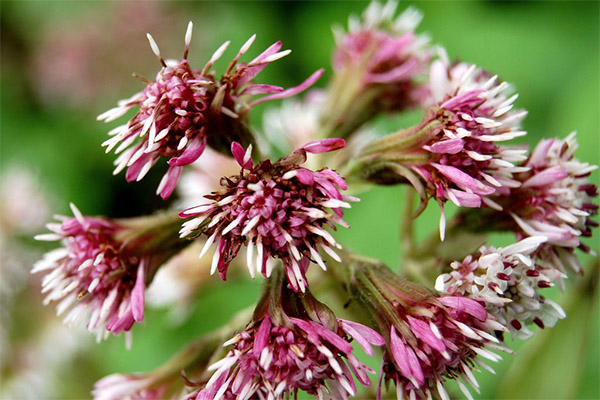
Infusion
To prepare an aqueous infusion, you need to use dry, crushed whitetail leaves. For 1 tablespoon of raw materials, you need to take 600 ml of water. The maximum dosage of such a remedy per day is 150 ml, no more. The fact is that there are medical recommendations regarding the maximum allowable dose of toxic alkaloids, which enter the body with the infusion on par with the useful substances.
Tincture
Alcohol or vodka tincture is usually prepared from the rhizome of the plant, but the inflorescences and leaves can also be used for this purpose. The technology of creating a remedy is quite simple:
- It is necessary to take a bottle of dark glass;
- Pour at the bottom 2 tablespoons of crushed dried raw materials;
- Pour 500 ml of vodka (or 250 ml of medical alcohol);
- insist 14-20 days, shake vigorously periodically;
- strain and filter (must, otherwise the shelf life will be short);
- Pour into a dry clean container.
Single dose for taking vodka tincture - 1 teaspoon. If the remedy was prepared on alcohol, you need to drink 30 drops 3-4 times a day.
Decoction
If you boil herbal raw materials in boiling water, the liquid will contain more active substances, which means that decoctions are more effective for various diseases. The main thing is not to overdo it, so as not to evaporate most of the components of the plant, otherwise the effect will be opposite - at the output will be only a useless slurry with a herbal taste.
The decoction can be made from the roots or from the leaves of the plant. Recipe for a remedy from the dried above-ground part of bellflower:
- 20 g of leaves;
- 1 liter of boiling water.
Boil the raw material for 20 minutes over low heat, then remove the pan from the stove, let it cool, without opening the lid, and strain the liquid. You can use the same principle to prepare a decoction of the rhizome. Raw materials should be taken in a ratio of 1:10, that is, for 100 g - 1 liter of water. Boil the roots should be longer, up to 40 minutes, and then the scheme is the same - cool, strain and store in the refrigerator.
Applications in cosmetology
Butterbur also has health benefits that are used in cosmetology. This herb helps to revitalize the skin, lighten it and cleanse the pores. For hair, the herb can serve as a powerful strengthening agent, and it can also stimulate cell regeneration processes in the hair follicles, due to which the growth is activated. There are several popular recipes for using butterbur for skin and hair beauty.
Facial Massage
The remedy removes black spots and eliminates inflamed pimples and blackheads. It is prepared from the following ingredients:
- 100 ml of olive oil;
- 20 grams of crushed leaves.
Simmer for 30 minutes at 70 degrees in the oven, cool and strain. Use in the evenings to massage, and rinse off after the treatment.
Balm for the hair
This is a healing remedy for all hair problems. It produces the following effects:
- Strengthens the roots;
- stimulates the growth;
- Reduces the greasiness of the scalp;
- It eliminates dandruff;
- Stops hair loss even at the alopecia stage.
To prepare it, take 20 g of butterbur leaves, 10 g of nettles and 10 g of a mixture of birch leaves and buds. These ingredients pour 2 liters of cold water and over low heat bring to a boil. Then immediately turn off and cover. Use to rinse hair after washing, you can every day.
Therapeutic lotion for the face
You can prepare a real cure, which will help to cope with acne, seborrhea, dermatitis. To do this, follow these instructions:
- Take 2 tablespoons of leaves;
- Boil for 15 minutes in a glass of water (150 ml);
- Cool and strain.
To the broth add 50 ml of alcoholic tincture of marigold, shake and send to the refrigerator for a day.
Use 2 times a day, to wipe clean skin before applying nourishing cream. For a pronounced result, it is important regularity. If wiped every day, after two weeks you can see a noticeable effect.
Contraindications for use
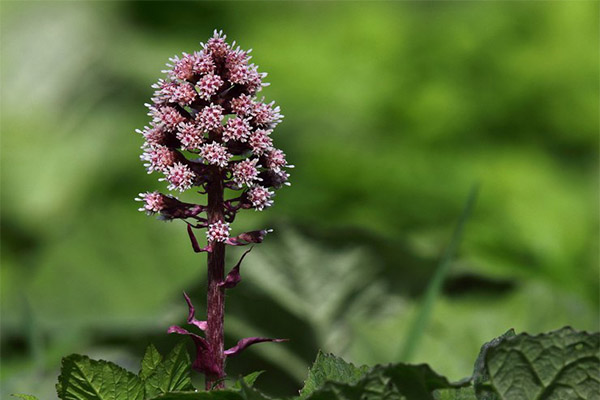
White knotweed is a hepatotoxic plant, so it should not be used to treat people with liver diseases, which are accompanied by a violation of the functioning of this organ. It is categorically forbidden to use belokoputnik in the case of hypersensitivity reactions. If this herb provokes an allergic reaction, the use can only harm the body.
With caution, you should use the plant in chronic inflammation in the organs of the gastrointestinal tract, as well as in cardiovascular diseases. Sagebrush is forbidden to drink during pregnancy and while breastfeeding.
As you can see, white knotweed is a valuable medicine, but its benefits can be appreciated only by those who properly dosage the remedies and do not violate the requirements concerning the duration of the course. Otherwise, whitebriar turns from a useful herb into a poison for the liver.
«Important: All information on the site is provided solely for introductory purposes. Before applying any recommendations, consult with a specialized specialist before applying any of the recommendations. Neither the editors nor the authors shall be liable for any possible harm caused by materials."

